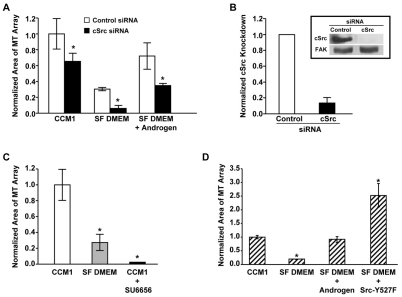Fig. 4.
Androgen promotes microtubule regrowth through a mechanism requiring Src-family kinases. (A,B) siRNA targeting Src inhibited microtubule regrowth. HFFs transfected with control or Src siRNA were serum starved and replated onto fibronectin in CCM1, SF DMEM or SF DMEM plus androgen, with androgen added only during the regrowth period. The extent of microtubule regrowth was measured 5 minutes post-nocodazole washout. Values are the normalized mean area ± s.d. calculated from 150 cells per condition in each of three independent experiments. *Values for Src siRNA-treated cells that are statistically different from those of control siRNA-treated cells (P<0.05). (B) Quantification of Src protein levels in cells treated with either control or Src siRNA. Data is from the three independent experiments in A. Inset: representative western blot. (C) The Src kinase inhibitor SU6656 suppresses microtubule regrowth at 5 minutes post-nocodazole washout. HFFs were serum starved and replated onto fibronectin in either CCM1 or SF DMEM. SU6656 was added to CCM1 during the last half hour of nocodazole treatment and in all solutions thereafter. Values are the normalized mean areas ± s.d. calculated from 150 cells per condition in each of three independent experiments. (D) Expression of the constitutively active Src-Y527F mutant promotes microtubule regrowth (for control see supplementary material Fig. S2C). Transfected HFFs were serum-starved and replated onto fibronectin in either CCM1 or SF DMEM and analyzed for regrowth. Values are the normalized mean area ± s.d. calculated from 150 cells per condition in each of three independent experiments. Asterisks in C and D indicate a statistically significant difference from the CCM1 control (P<0.05).

